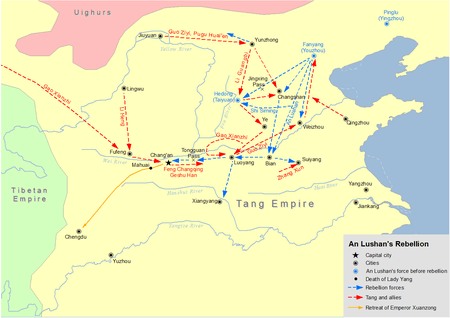Yan (An–Shi)
Yan (Chinese: 燕; pinyin: Yān), also known as the Great Yan (Chinese: 大燕; pinyin: Dà Yān), was a state established in 756 by the Tang Dynasty general An Lushan, after he rebelled against the reign of Emperor Xuanzong of Tang in 755. The state was extinguished in 763, with the death of An Lushan's former subordinate, Shi Siming's son, Shi Chaoyi, who was the last person to claim the title as Yan's emperor.

Map showing the An Lushan Rebellion
Yan 燕 | |||||||||
|---|---|---|---|---|---|---|---|---|---|
| 756–763 | |||||||||
| Capital | Luoyang (756–757) Yecheng (757–759) Fanyang (759) Luoyang (759–762) | ||||||||
| Common languages | Chinese | ||||||||
| Religion | Buddhism, Taoism, Confucianism, Chinese folk religion | ||||||||
| Government | Monarchy | ||||||||
| Emperor | |||||||||
• 756–757 | An Lushan, 1st | ||||||||
• 757–759 | An Qingxu, 2nd | ||||||||
• 759–761 | Shi Siming, 3rd | ||||||||
• 761–763 | Shi Chaoyi, 4th | ||||||||
| Historical era | An Lushan Rebellion | ||||||||
• An Lushan's self-declaration as emperor | February 5 756 | ||||||||
• Shi Chaoyi's suicide | 763 | ||||||||
| Currency | Chinese coin, Chinese cash | ||||||||
| |||||||||
| Today part of | China | ||||||||
Rulers of Yan
| Temple name | Posthumous name | Personal name | Duration of reign | Era name |
|---|---|---|---|---|
| None | La (剌 là) | An Lushan | 756-757 | Shengwu (聖武 Shèngwǔ) |
| None | None | An Qingxu | 757-759 | Tiancheng (天成 Tiānchéng) |
| None | None | Shi Siming | 759-761 | Shuntian (順天 Shùntiān) 759-761 Yingtian (應天 Yìngtiān) 761 |
| None | None | Shi Chaoyi | 761-763 | Xiansheng (顯聖 Xiǎnshèng) |
gollark: No, it's Esowiki's fault.
gollark: Now, my crawler thing's HTTP client followed the request, but didn't note it, so it accidentally indexed a bunch of Wikipedia while thinking it was Esowiki.
gollark: I figured out the problem! Esowiki is being stupid and for some reason you can link to `Wikipedia:Whatever` and it links to Wikipedia.
gollark: Okay, mystery solved! Ish! Not really! It's crawling the links to nonexistent pages and fetching them anyway.
gollark: Well, the link input-into-database code seems sound.
See also
This article is issued from Wikipedia. The text is licensed under Creative Commons - Attribution - Sharealike. Additional terms may apply for the media files.